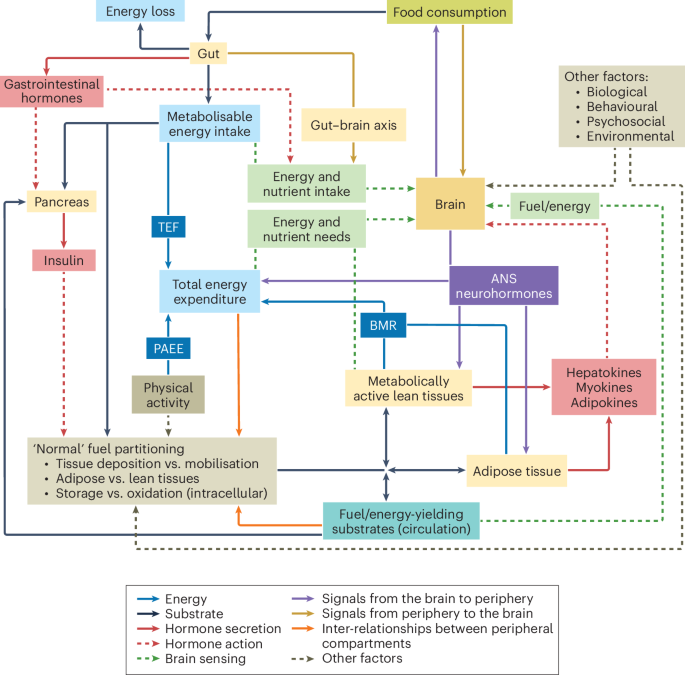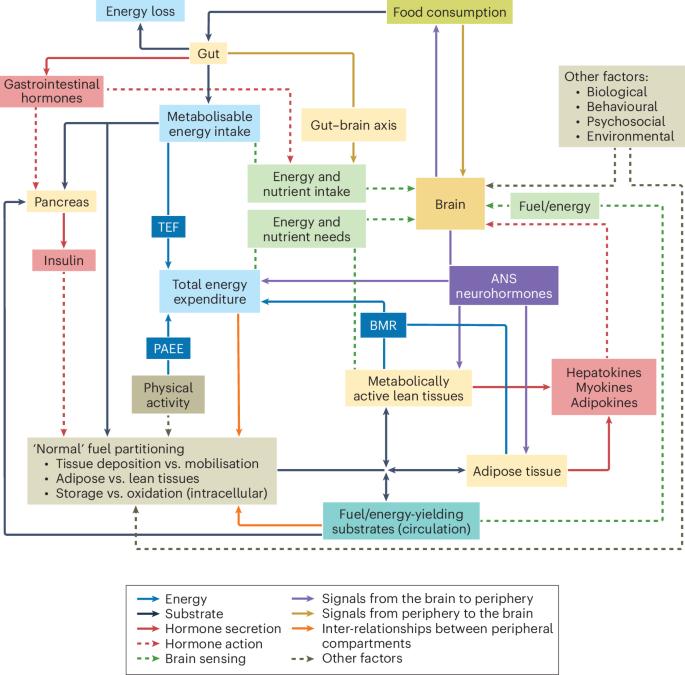On the pathogenesis of obesity: causal models and missing pieces of the puzzle
IF 18.9
1区 医学
Q1 ENDOCRINOLOGY & METABOLISM
引用次数: 0
Abstract
Application of the physical laws of energy and mass conservation at the whole-body level is not necessarily informative about causal mechanisms of weight gain and the development of obesity. The energy balance model (EBM) and the carbohydrate–insulin model (CIM) are two plausible theories, among several others, attempting to explain why obesity develops within an overall common physiological framework of regulation of human energy metabolism. These models have been used to explain the pathogenesis of obesity in individuals as well as the dramatic increases in the prevalence of obesity worldwide over the past half century. Here, we summarize outcomes of a recent workshop in Copenhagen that brought together obesity experts from around the world to discuss causal models of obesity pathogenesis. These discussions helped to operationally define commonly used terms; delineate the structure of each model, particularly focussing on areas of overlap and divergence; challenge ideas about the importance of purported causal factors for weight gain; and brainstorm on the key scientific questions that need to be answered. We hope that more experimental research in nutrition and other related fields, and more testing of the models and their predictions will pave the way and provide more answers about the pathogenesis of obesity than those currently available. This authoritative Perspective lays a foundation for the field of obesity research by comparing commonalities and differences between competing models of obesity pathogenesis and by defining terms that are at the core of this discussion.


肥胖症的发病机理:因果模型和缺失的拼图碎片
在全身层面应用能量和质量守恒的物理定律并不一定能说明体重增加和肥胖症发展的因果机制。能量平衡模型(EBM)和碳水化合物-胰岛素模型(CIM)是两个貌似合理的理论,还有其他一些理论,试图在人体能量代谢调节的总体共同生理框架内解释肥胖症的发病原因。这些模型被用来解释个体肥胖症的发病机理,以及过去半个世纪以来全球肥胖症发病率急剧上升的原因。在此,我们总结了最近在哥本哈根举行的一次研讨会的成果,这次研讨会汇聚了来自世界各地的肥胖症专家,共同讨论肥胖症发病机理的因果模型。这些讨论有助于对常用术语进行操作性定义;划定每种模式的结构,特别是重点关注重叠和分歧的领域;对声称的体重增加因果因素的重要性提出质疑;并就需要回答的关键科学问题集思广益。我们希望,更多的营养学和其他相关领域的实验研究,以及对模型及其预测的更多测试,将为肥胖症的发病机制铺平道路,并提供比目前更多的答案。
本文章由计算机程序翻译,如有差异,请以英文原文为准。
求助全文
约1分钟内获得全文
求助全文
来源期刊

Nature metabolism
ENDOCRINOLOGY & METABOLISM-
CiteScore
27.50
自引率
2.40%
发文量
170
期刊介绍:
Nature Metabolism is a peer-reviewed scientific journal that covers a broad range of topics in metabolism research. It aims to advance the understanding of metabolic and homeostatic processes at a cellular and physiological level. The journal publishes research from various fields, including fundamental cell biology, basic biomedical and translational research, and integrative physiology. It focuses on how cellular metabolism affects cellular function, the physiology and homeostasis of organs and tissues, and the regulation of organismal energy homeostasis. It also investigates the molecular pathophysiology of metabolic diseases such as diabetes and obesity, as well as their treatment. Nature Metabolism follows the standards of other Nature-branded journals, with a dedicated team of professional editors, rigorous peer-review process, high standards of copy-editing and production, swift publication, and editorial independence. The journal has a high impact factor, has a certain influence in the international area, and is deeply concerned and cited by the majority of scholars.
 求助内容:
求助内容: 应助结果提醒方式:
应助结果提醒方式:


